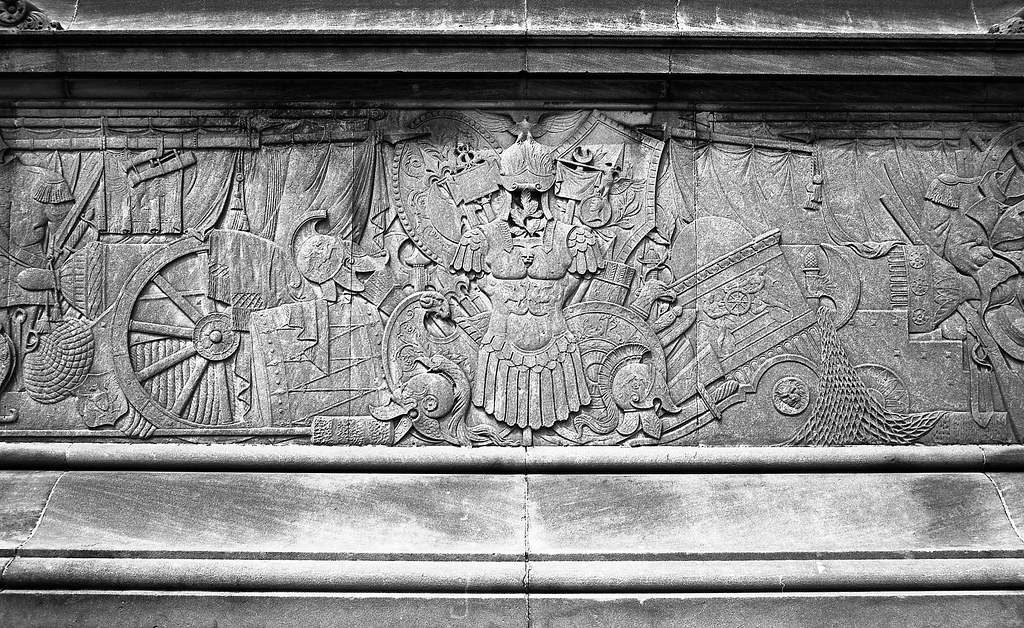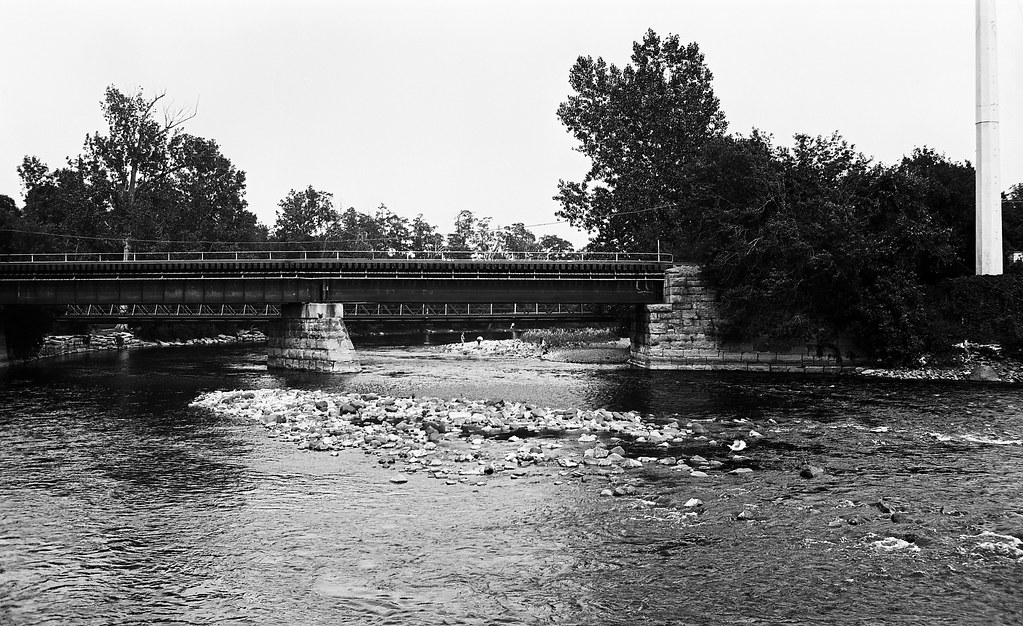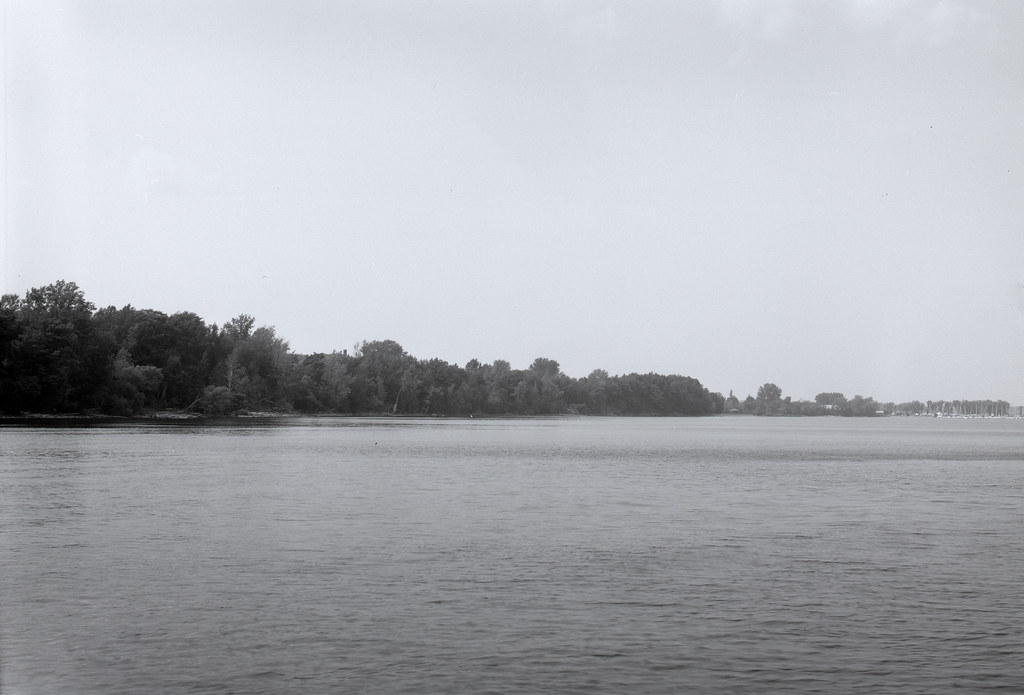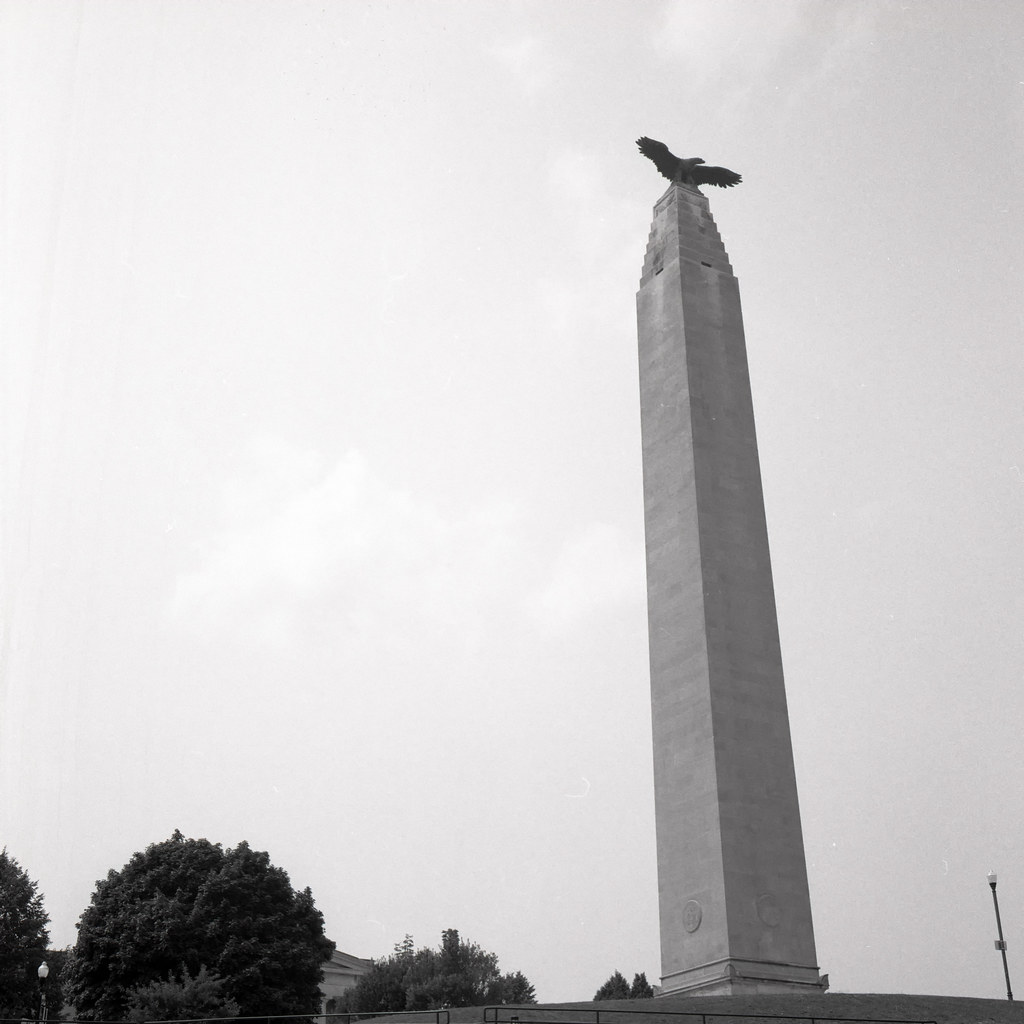While the Battle of Lake Erie was considered the greatest inland naval battle of 1813, the Battle of Plattsburg or rather Battle of Lake Champlain was the greatest inland naval battle of 1814. By fall of 1814 the British army had beaten back Napoleon and was pouring troops into North American at a rapid pace, already General Robert Ross had burning Washington DC and was marching for Baltimore, another force had captured most of what would become Maine. Yeo and Chauncy continued to chase each other around Lake Ontario, and Lake Huron had been secured under British control with the bold captures of the Tigress and Scorpion by the vengeful crew of the Nancy. And now that Prevost had a large body of troops at his disposal, he could finally start an offensive war.

A house in Chazy, New York that was used by Prevost and his Senior officers as a headquarters on their way to Plattsburg
Rolleiflex 2.8F – Carl Zeiss Planar 80mm 1:2.8 – Kodak TMax 400 – Kodak TMax developer (1+9) 20:00 @ 20C
The Iron Duke, Sir Arthur Wellesley had personally chosen three of his best generals to assist George Prevost along with a body of troops, some veterans of the peninsular war, or reserve forces in England, to supplement Prevost’s veterans at Quebec City. General Fredrick Robinson would command a brigade made up of troops from the 27th, 39th, 76th, and 88th Regiments, General Mainly Powers would command troops from the 27th, 5th, 3rd, and 58th Regiments, and command of the exsisting forces from the 8th, 49th, 13th, Voltiguers, and Canadian Chasseurs would go to General Thomas Brisbane, over all command, much to these men’s chagrin was given to General Francis de Rottenburg with Prevost coming along as well. Additional support was provided by Royal Artillery in the form of field guns and howitzers, also a squadron from the 19th Light Dragoons was attached. They felt this colonial administrator had been fighting a defensive war for so long and lacked any real experience in an offensive war. But this was only half of the invasion force. Prevost was counting on the Lake Champlain squadron, still under construction for the most part, after they found out about the American Squadron already on the lake. The squadron under Captain George Downie consisted of H.M. Frigate Confidence (37), still under construction, H.M. Sloop Chubb (11), H.M. Sloop Linnet (16), H.M. Sloop Finch (11). At Plattsburg, General Alexander McComb was at a loss, under orders from Secretary of War, John Armstrong, General George Izard had marched off with a bulk of his regular troops, well trained me, to reinforce Sacket’s Harbor and from there Fort Erie still under siege from General Gordon Drummond. McComb was left with untrained regulars and militia troops, who were fairly poorly equipped. But the real power at Plattsburg lay in the naval squadron on the lake. Master Commandant Thomas Macdonough commanded a force of ships from his flagship U.S. Corvette Saratoga (26), U.S. Brig Eagle (20), U.S. Schooner Ticonderoga (17), and U.S. Sloop Preble (9) supported by gunships.

Close up details on the Macdonough Monument in downtown Plattsburg
Nikon F4 – AF Nikkor 35mm 1:2D – Eastman 5363 @ ASA-25 – PMK Pyro (1+2+100) 11:00 @ 20C
Prevost’s army moved fast south from Lower Canada, sweeping into New York State, any attempt to stop them was met with swift action, even the artillery bombardments did little to slow this army. But both men had their own surprises. McComb had his troops fall back, destroying bridges, making false trails, and changing signs. Macdonough, knowing he would not survive an open water battle with the British squadron, opted to anchor his ships in a line in Plattsburg Bay, making Downie come to him. And while the Royal Navy had destroyed many fleets at anchor, most notably Nelson’s victory at the Nile, Plattsburg Bay’s geography prevented Downie from repeating the feat. But the main problem Prevost faced much to the distain of his staff officers was the lack of intelligence, and his unwillingness to get the needed intelligence, feeling that trying to buy out the local population would not work and those who accepted the money would mislead the invading force. So he kept the purse shut to his secret service fund, and denied access to the generals as well. Robinson, being no stranger to the campaign took it upon himself to find out the details of the American positions on the south bank of the Saranac River. The American defenses were formitable but incomplete, a quick strike would easily overwhelm them. But Prevost had it in his mind that no assault on land would succeed as long as the Americans controlled the lake. But Downie was unwilling to move his squadron into the lake, the Confidence remained incomplete and the weather was not in his favour. But Prevost continued to goad the captain. While the land forces continued to exchange meaningless small arms and artillery fire. At least Robinson had found a fordable spot on the river that would give the British an easy path to outflank and attack from the rear surprising the Americans.

The Saranac River today in downtown Plattsburg
Nikon F4 – AF-S Nikkor 35mm 1:2D – Eastman 5363 @ ASA-25 – PMK Pyro (1+2+100) 11:00 @ 20C
So Prevost waited on Downie and Downie on his shipbuilders, but he finally could not stand Prevost’s constant nagging and moved his squadron out onto the lake, her crews and guns untested. He made a deal with Prevost, that the attack would be simultaneous, he would strike Macdonough’s squadron, while Prevost would launch a land attack to seize the American batteries and turn them against the ships, forcing Macdonough’s squadron onto the lake. But the weather kept Downie at port. He finally was able to put to sail by midnight on the 9th, arriving at Cumberland Head, Prevost wanted to attack on the 10th, but again the weather kept him at anchor. At dawn on the 11th of September, Downie was confident the weather and wind would remain in his favour, and ordered his guns scaled, fired with powder only, to clear the new guns for action, this was the prearranged signal for Prevost to launch his ground assault. When Prevost heard the signal, he called his generals, telling them to wait and hour and march off at 10am. Downie however moved his squadron into position to strike the American Squadron. It was the Eagle who took the first shot, falling short of the Confidence, the Linett fired its own broadside into the Saratoga doing little damage. But it was enough to move both squadrons into general action. And Downie was concerned that there was no sound of the land battle, but continued to move his own ship into action, while Macdonough is already sighting his long guns for action and sends a shot through the Confidence. Downie undeterred sails through the smoke and enemy fire, not able to maneuver as he first wished due to changing winds drops anchor a good 400 yards off the Saratoga and swings his ship into line but the move cost him two of his anchors and fowled another two in the process but he was now ready and sends a seven hundred pound broadside into the Saratoga. Macdonough can only watch as crew are killed in an instant, and many more wounded. His crew however is professional and well trained and soon respond with one of their own, and the two great ships are pounded on each other broadside for broadside. Downie is killed in one such broadside, crushed by one of his own 24-pound guns. Seeing their flag ship under fire the Chubb and Linett move in, only to be countered by the Eagle, the Chubb is soon overwhelmed, drifts out of action, only six crew surviving and strikes their colours. At the far end of the line, the Finch and several gunboats engaged the Preble and Ticonderoga, the Preble is quickly forced out of action. The two remain ships continue to exchange fire, the Ticonderoga begins to take on fire, but the captain of the Finch loses control of his ship as the winds change and ends up on the shoals around Crab Island, after an artillery exchange with the island’s battery strikes his colours well. With the loss of the Finch, the Ticonderoga quickly mops up the remaining gunships. At the head of the line the three big ships continue to pound each other. Both sides are in rough shape, crews and guns were reaching the breaking point. The Eagle was the first to lose her starboard battery, cutting her cables, the ship performs a maneuver called winding, turning the ship on the central axis to bring the port batteries to bear, but in doing so exposed the Saratoga to raking fire from the Linett, the action effectively silencing the Saratoga’s starboard guns. Macdonough has however been prepared for such an event and puts his spring line into action, using a complex combination of anchor movements and riggings winds his own ship quickly and as gun after gun comes to bear pours fresh fire into the Confidence. James Robertson, now in command on the Confidence inspired by this move tries to do the same, but the loss of several anchors earlier leaves his ship at an awkward angle unable to bring his own fresh guns to bear, the ship is raked from bow to stern by the Saratoga and Eagle, and he is left with no choice but to strike his colours, the Linett lasts a little longer but surrenders as well.

Lake Champlain Today
Modified Anniversary Speed Graphic – Fuji Fujinon-W 1:5.6/125 – Fuji Acros 100 – Kodak Xtol (1+1) 9:30 @ 20C
But the question was where was the support from the army, Robinson’s assault against the American batteries, turning them on the American squadron to catch Macdonough between two fires. They had in fact gotten lost, Prevost’s delay on getting them marching and MacComb’s deception had gotten the brigade turned around. By the time they had found the ford, the Chubb, Preble and Finch were out of the action already. Upon hearing the cheers from the lake, Robinson sends an aide back to headquarters to see who had won the contest, then ordered his brigade to cross. Under heavy fire from American riflemen, his disaplined troops quickly form to line and give fire, chasing the Americans back to their fortifications, he and his equal number in General Brisbane are in a clear position to strike and seize the American fortifications with little difficulty, at least until the aide returns with word of Downie’s defeat and orders to retreat. Both men plead to let them continue and maybe they could force the tired American squadron to surrender under heavy fire from the shore. Prevost is unconvinced, and had word that nearly 20,000 fresh American militia forces were already on the march to reinforce the garrison. Prevost it turned out later fell for the same ruse Brock used to trick Hull into surrendering at Detroit. But it was enough and the general quickly marched the forces off, leaving behind supplies and equipment, the undefended town is soon raided by their own militia. Aboard the Saratoga, Robertson and the surviving senior offers present their swords in formal surrender to Macdonough, but the commandant would have none of that, they fought with honour and told them to return their swords to their sheaths.

The Macdonough Monument in downtown Plattsburg
Rolleiflex 2.8F – Carl Zeiss Planar 80mm 1:2.8 – Kodak TMax 400 – Kodak TMax Developer (1+9) 20:00 @ 20C
The British defeat at Plattsburg and Lake Champlain would have far reaching effects on the negotiations happening in Ghent. Without the capture of a major port and an inland lake, the British demand for a native buffer zone was put to rest. Prevost would also be called to account for his actions during the battle, being recalled to England in 1815. While it is easy to blame Prevost for Plattsburg, and yes, it was his actions that directly lead to the defeat by forcing Downie to fight on unfavourable terms against a while trained opposing force, using an untested ship and unfamiliar crew, and then ordering a disorderly retreat that could have been at least a land victory for the British, the odds were stacked against him. But he had fought a mostly defensive war to this point, and should have stepped aside for a more seasoned general in an offensive war. Macdonough’s effective use of a spring line and winding was more a testament to his excellent command and seamanship than of naval genius and was the maneuver that turned the battle to his favour. Today, Plattsburg is a bustling small city, Lake Champlain is filled with pleasure crafts. A large monument stands in the downtown to Macdonough’s victory, and a museum dedicated to the battle is located in the former air force base. Sadly there’s no monument the McComb in Plattsburg, however there is a statue of him in downtown Detroit, MI. US Route 9 follows the approximate invasion path of Prevost’s army.
Written Files from:
Collins, Gilbert. Guidebook to the Historic Sites of the War of 1812. Toronto: Dundurn, 2006. Print.
Hickey, Donald R. Don’t Give up the Ship!: Myths of the War of 1812. Urbana: U of Illinois, 2006. Print.
Berton, Pierre. Flames across the Border, 1813-1814. Markham, Ont.: Penguin, 1988. Print.
Web: www.eighteentwelve.ca/?q=eng/Topic/53